The Kaveri Refresh 'Godavari' Review: Testing AMD's A10-7870K
by Ian Cutress on June 1, 2015 11:59 AM ESTGaming Benchmarks: Mid-Range
Alien: Isolation
If first person survival mixed with horror is your sort of thing, then Alien: Isolation, based off of the Alien franchise, should be an interesting title. Developed by The Creative Assembly and released in October 2014, Alien: Isolation has won numerous awards from Game Of The Year to several top 10s/25s and Best Horror titles, ratcheting up over a million sales by February 2015. Alien: Isolation uses a custom built engine which includes dynamic sound effects and should be fully multi-core enabled.
For low end graphics, we test at 720p with Ultra settings, whereas for mid and high range graphics we bump this up to 1080p, taking the average frame rate as our marker with a scripted version of the built-in benchmark.
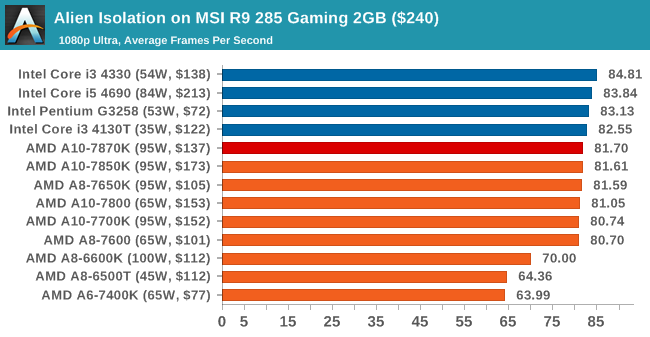
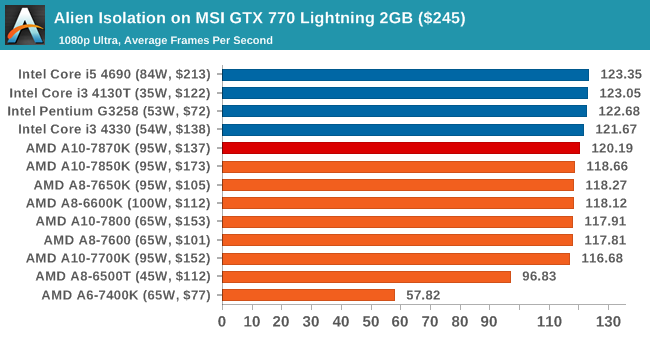
Total War: Attila
The Total War franchise moves on to Attila, another The Creative Assembly development, and is a stand-alone strategy title set in 395AD where the main story line lets the gamer take control of the leader of the Huns in order to conquer parts of the world. Graphically the game can render hundreds/thousands of units on screen at once, all with their individual actions and can put some of the big cards to task.
For low end graphics, we test at 720p with performance settings, recording the average frame rate. With mid and high range graphics, we test at 1080p with the quality setting. In both circumstances, unlimited video memory is enabled and the in-game scripted benchmark is used.
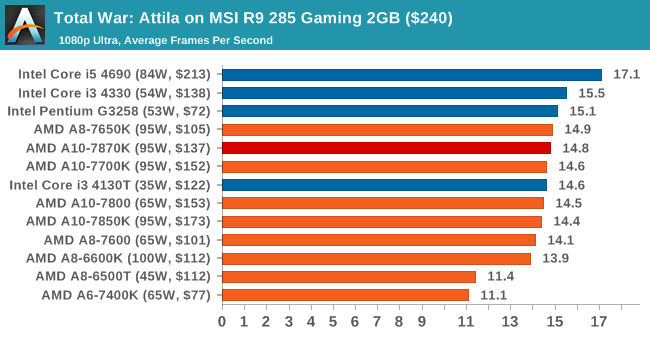
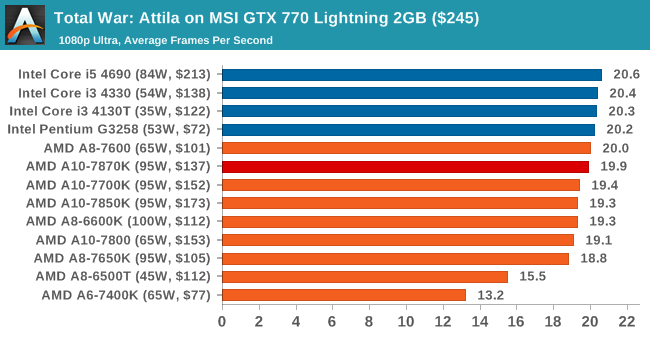
Grand Theft Auto V
The highly anticipated iteration of the Grand Theft Auto franchise finally hit the shelves on April 14th 2015, with both AMD and NVIDIA in tow to help optimize the title. GTA doesn’t provide graphical presets, but opens up the options to users and extends the boundaries by pushing even the hardest systems to the limit using Rockstar’s Advanced Game Engine. Whether the user is flying high in the mountains with long draw distances or dealing with assorted trash in the city, when cranked up to maximum it creates stunning visuals but hard work for both the CPU and the GPU.
For our test we have scripted a version of the in-game benchmark, relying only on the final part which combines a flight scene along with an in-city drive-by followed by a tanker explosion. For low end systems we test at 720p on the lowest settings, whereas mid and high end graphics play at 1080p with very high settings across the board. We record both the average frame rate and the percentage of frames under 60 FPS (16.6ms).

![Grand Theft Auto V on MSI R9 285 Gaming 2GB ($240) [Under 60 FPS]](https://images.anandtech.com/graphs/graph9307/74874.png)
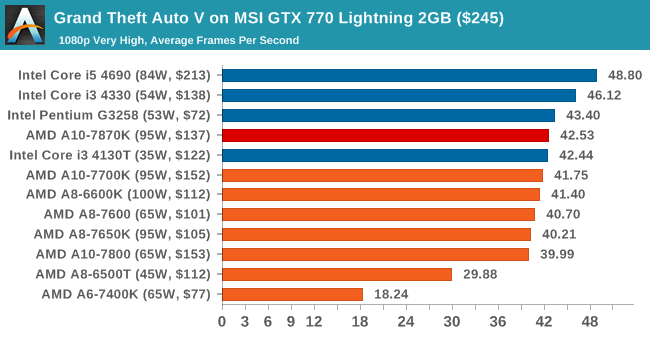
![Grand Theft Auto V on MSI GTX 770 Lightning 2GB ($245) [Under 60 FPS]](https://images.anandtech.com/graphs/graph9307/74884.png)
GRID: Autosport
No graphics tests are complete without some input from Codemasters and the EGO engine, which means for this round of testing we point towards GRID: Autosport, the next iteration in the GRID and racing genre. As with our previous racing testing, each update to the engine aims to add in effects, reflections, detail and realism, with Codemasters making ‘authenticity’ a main focal point for this version.
GRID’s benchmark mode is very flexible, and as a result we created a test race using a shortened version of the Red Bull Ring with twelve cars doing two laps. The car is focus starts last and is quite fast, but usually finishes second or third. For low end graphics we test at 1080p medium settings, whereas mid and high end graphics get the full 1080p maximum. Both the average and minimum frame rates are recorded.
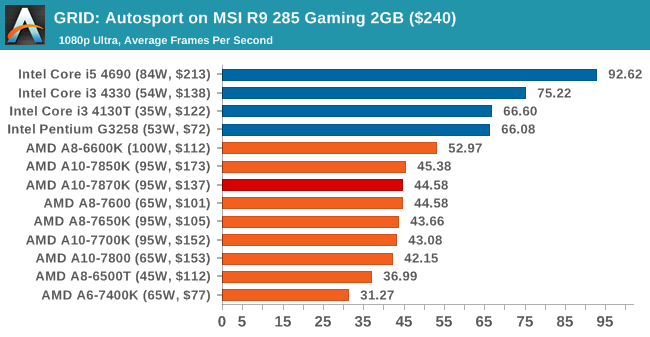
![GRID: Autosport on MSI R9 285 Gaming 2GB ($240) [Minimum FPS]](https://images.anandtech.com/graphs/graph9307/74876.png)

![GRID: Autosport on MSI GTX 770 Lightning 2GB ($245) [Minimum FPS]](https://images.anandtech.com/graphs/graph9307/74886.png)
Middle-Earth: Shadows of Mordor
The final title in our testing is another battle of system performance with the open world action-adventure title, Shadows of Mordor. Produced by Monolith using the LithTech Jupiter EX engine and numerous detail add-ons, SoM goes for detail and complexity to a large extent, despite having to be cut down from the original plans. The main story itself was written by the same writer as Red Dead Redemption, and it received Zero Punctuation’s Game of The Year in 2014.
For testing purposes, SoM gives a dynamic screen resolution setting, allowing us to render at high resolutions that are then scaled down to the monitor. As a result, we get several tests using the in-game benchmark. For low end graphics we examine at 720p with low settings, whereas mid and high end graphics get 1080p Ultra. The top graphics test is also redone at 3840x2160, also with Ultra settings, and we also test two cards at 4K where possible.
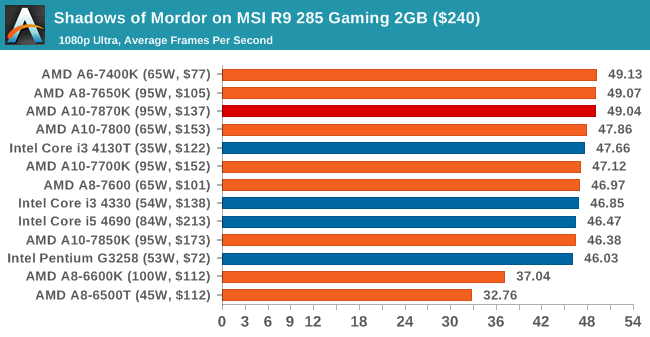
![Shadows of Mordor on MSI R9 285 Gaming 2GB ($240) [Minimum FPS]](https://images.anandtech.com/graphs/graph9307/74878.png)

![Shadows of Mordor on MSI GTX 770 Lightning 2GB ($245) [Minimum FPS]](https://images.anandtech.com/graphs/graph9307/74890.png)
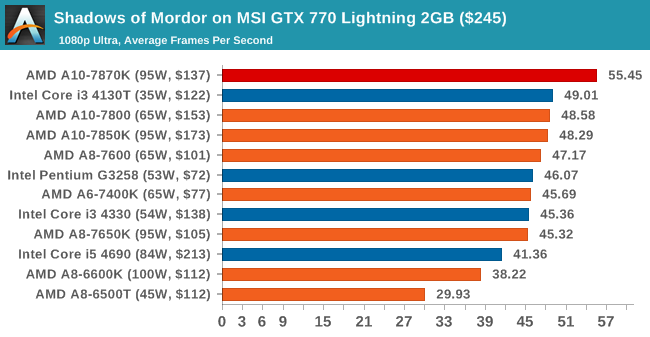
![Shadows of Mordor on MSI GTX 770 Lightning 2GB ($245) [Minimum FPS]](https://images.anandtech.com/graphs/graph9307/74888.png)
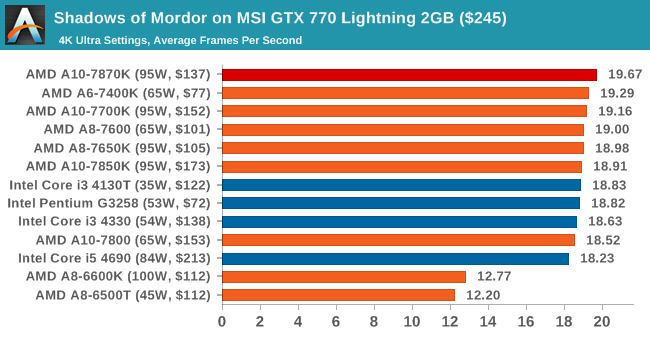
![Shadows of Mordor on MSI GTX 770 Lightning 2GB ($245) [Minimum FPS]](https://images.anandtech.com/graphs/graph9307/74890.png)
Conclusions on Mid-Range Graphics
The extra CPU frequency of the A10-7870K, and most likely the rise in base frequency from 3.7 GHz on the 7850K to 3.9 GHz, helps the 7870K be the best performing AMD APU we have tested, even if in most cases we are looking at single digit increases in frame rates. That being said, Alien Isolation pushed above 120 FPS, which is an achievement for 120 FPS panels, but if we factor in something like Freesync, the frame rates where all these cards are playing will help with action responsiveness of the user to the in-game motion.















140 Comments
View All Comments
MrSpadge - Monday, June 1, 2015 - link
There are reports that this chip throttles back to 1600 MHz quickly after being loaded, only to jump up to a turbo mode for a short time and back to throttling again. This might due to unfinished pre-release bioses, but AMD certainly changed the performance tuning. And applies a mad voltage to this chip.silverblue - Monday, June 1, 2015 - link
Apparently, it was an early BIOS that caused the throttling, and as such has now been fixed.Valantar - Tuesday, June 2, 2015 - link
From what's being said in the forums, stock voltages for these chips are ludicrously high - in the 1.4-1.5V range! - causing all kinds of throttling and other odd behavior. From what's being said there, most Kaveri chips run just fine at stock speeds at~1.2V, so this overvolting is causing some real havoc in the test results. I would love to see AT look into this, at least for a bit, as it could cause some serious differences in both speed add power usage.tabascosauz - Tuesday, June 2, 2015 - link
The 7850K auto-throttles to 3.0GHz CPU-side whenever iGPU is pulling a lot of watts. It's a known issue that basically can't be fixed, probably because AMD is too paranoid about more ASRock A88X-ITXs blowing up under load. I wouldn't be surprised if the 7870K doesn't suffer from the same thing. The CPU speed boosts are always nonsense with Kaveri; the APU runs into its thermal envelope faster than you can say "throttling".Maybe AMD should start setting spec for VRM design. VRM design is the one killing AM3+, since MSI clearly doesn't know how to make them properly on that platform. FM2+, being the modern platform, shouldn't even have to address these problems (AMD should have made the necessary precautions), but it must if AMD wants to make any money.
Hobbitter - Friday, June 5, 2015 - link
I recieved a Asus crossblade ranger fm2+ and i had to send it back because of the VRM, they burnt my finger as soon as i touched them they were that hot. Plus it kept shutting my computer down even with a desk fan it would be red hot. could be a common problem with these APU's.Gigaplex - Monday, June 1, 2015 - link
I don't see how the conclusions match the test results. In many (arguably the majority) the new chip was bested by at least one other older AMD chip yet the conclusions of each segment pretty much state that the new chip is the clear winner. What?lefty2 - Monday, June 1, 2015 - link
You are correct. He says "almost all of our graphics tests saw a gain over the previous head of the Kaveri list".This is plainly not true. The test results show that Alien Isolation, Total War Attila and GRID autosport it's slower than 7850K. That's 3 out 5 games where it's slower! and it seems that most of the CPU tests it's slower than older Kavari CPUs.
jeffrey - Monday, June 1, 2015 - link
"I don't see how the conclusions match the test results. In many (arguably the majority) the new chip was bested by at least one other older AMD chip yet the conclusions of each segment pretty much state that the new chip is the clear winner. What?"Agree 100% !! All I could think of while reading the review was how bad AMD's scaling looked and how the 7870K was dominated by the 7850K. I figured I was going to get to a page somewhere in the review explaining why it trailed the outgoing chip so often and then bam, dat conclusion tho..
FriendlyUser - Monday, June 1, 2015 - link
Thanks for the review guys, much appreciated as I am considering one for my brother.nikaldro - Monday, June 1, 2015 - link
You're better of with a pentium + GTX750 in most cases